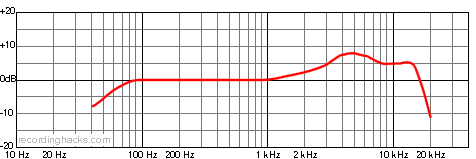 Sennheiser Electronics Corporation MD 421-II
Sennheiser Electronics Corporation MD 421-II
Cardioid Dynamic Microphone
Truly a classic microphone, the MD 421 has been a fixture in recording studios since its introduction in 1960.
The MD421 has a 5-position bass roll-off switch. The switch is not marked with specific frequencies or amounts (dB) of cut. The “flat” position is marked M for Music; the other extreme is marked “S” for Speech, and cuts the low end by approximately 6dB below 500 Hz. Three intermediate positions are provided.
The “Mk. II” edition was created in 2002. Hugh Robjohns of SoundOnSound researched the difference. In essence, the Mk. II was designed to sound the same as the original, but to cost less to manufacture.
Nonetheless, mic authority Scott Dorsey has said:
The only audible differences I know of are between the older units and the newer Mk. II. The Mk. II has a very different sound with a presence boost added that I don’t much like.
Sennheiser, 2010
Significant upgrades incorporated into the MD 421 II include a metal inner chassis for better weight distribution and, with the contour-fitted bass roll-off control, a shorter, sleeker housing. The glass composite housing and hardened stainless steel basket afford improved durability. With the acoustic components now enclosed in the inner chassis the mic is less sensitive to dust and humidity. Servicing is also easier with the new design, since individual components can be more easily replaced and self-sealing acoustic connections mean that adhesives and sealing compounds are no longer required.
 A special edition of the mic, called the MD 421 SE, was released to celebrate the 90th birthday of company founder Dr. Fritz Sennheiser. Visually distinctive with a gold-plated grille, the mic was available in a limited production run of 990 units, and shipped in a wooden case with a signed certificate of authenticity. Curiously, this mic cost only $650, not significantly more than the MSRP on the Mk. II version of the microphone. Also worth noting is that the SE was claimed to “sonically recapture the original 1960s mic design,” suggesting that it lacks the presence peak that Scott Dorsey hears in the Mk. II edition.
A special edition of the mic, called the MD 421 SE, was released to celebrate the 90th birthday of company founder Dr. Fritz Sennheiser. Visually distinctive with a gold-plated grille, the mic was available in a limited production run of 990 units, and shipped in a wooden case with a signed certificate of authenticity. Curiously, this mic cost only $650, not significantly more than the MSRP on the Mk. II version of the microphone. Also worth noting is that the SE was claimed to “sonically recapture the original 1960s mic design,” suggesting that it lacks the presence peak that Scott Dorsey hears in the Mk. II edition.
Additional models of the MD421:
- MD421 N - 3-pin DIN 41524 connector. Has HPF.
- MD421-2 - 3-pin Tuchel plug. No HPF.
- MD421-U - XLR adaptor, HPF.
- MD 421-U-4 - has adapter for 3/8-inch threads
- MD 421-U-5 - has adapter for 5/8-inch x 27G threads
The MD 421 was inducted into the TEC Hall of Fame in 2011, following the mic’s 50th anniversary celebration in 2010. At the time of the TEC announcement, Sennheiser revealed that over 500,000 MD-421/MD-421-II microphones had been sold.
The Sennheiser Electronics Corporation MD 421-II is also known as: 421, MD421, MD421II.
The mic was released in 1960.
Specifications
| Frequency Response - CardioidClick Graph to Compare! |
|---|
 |
| Pickup Patterns | Pads & Filters |
|---|---|
|
Cardioid
(2 mV/Pa; 30 - 17,000 Hz) |
|
| Coil Diameter | Impedance | SPL/Noise |
|---|---|---|
| n/a | 200 Ohms (Low) | SPL n/a |
| Weight | Length | Max Diameter | Interface(s) |
|---|---|---|---|
| 385g (13.58oz) | 215mm (8.46'') | 49mm (1.93'') |
|
| Power Specifications |
|---|
Did we get anything wrong on this page? Please let us know!
